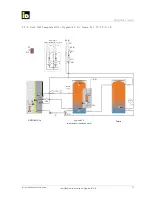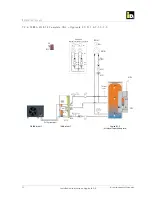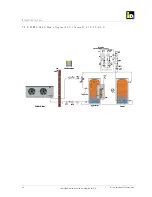
(C) IDM ENERGIESYSTEME GMBH
Installation instructions Hygienik 2.0
57
Declaration of Conformity
Ch
a
p
te
r 08
8. Heating water
8.1. Heating water quality
Depending on the quality of the heating water,
limescale (fi rmly adhering layer primarily consisting
of calcium carbonate) may form, particularly on heat
exchanger surfaces, i.e. in the event of a high calcium
hydrogen carbonate content, there is the danger of
increased limescale formation.
For this reason, we recommend softening / deminer-
alization in the case of systems with a water hardness
, that is, a calcium hydrogen carbonate concentration
Ca(HCO
3
)
2
, of more than 14°dH.
Contact your water supply company for information
on the concentration of calcium hydrogen carbonate
Ca(HCO
3
)
2
in your heating water.
Multiply by 0.179 to convert “degrees German hard-
ness (°dH) to the unit mol/m
3
.
With increasing size of buffer storage tanks, the ratio
between the limescale-forming constituents (due to the
high heating water content) and boiler output (heat
exchanger surface) becomes more and more unfavor-
able.
Examination of the limescale-forming constituents is
necessary in such systems. Heating (thermal inhibition)
of the heating water (see below) is always advisable.
From a concentration of 2.5 mol/m
3
(corresponding
roughly to 14°dH) upward and with performance
ratios of over 20 l/kW, excessive limescale formation
is possible, and appropriate countermeasures should
be implemented.
8.2. Ther mal inhibition of heating water
To prevent concentration of the limescale-forming con-
stituents in individual areas of the heat exchanger, we
recommend that after fi lling the system, as the last step
of commissioning, you heat the tank content.
By setting the maximum boiler output (for example, the
chimney sweep function) and maximum fl ow tempera-
tures for the consumers, limescale formation can be
distributed evenly and in a targeted manner over the
heat exchanger surfaces of the boiler.
The tank charging pump should be set to ON (manual
operation) during the heating process. This ensures
complete circulation of the water in the tank.
If the heating circuit temperatures allow this, the high
fl ow temperature should also be pumped at full pump
load through all heating circuits to ensure that all heat-
ing water is reached.
8.3. Treatment of the water in the heating
system
To prevent damage caused by corrosion, sludge ac-
cumulation and limescale in the heating system, the
water used to fi ll the tank and the heating system must
be treated in accordance with VDI guideline 2035,
EN 12828 and ÖNORM H5195.
The measures prescribed by these guidelines include
the following:
Softening and demineralization
The most effective measures to prevent the formation of
limescale are softening and demineralization. Calcium
and magnesium ions are removed from the water.
Physical measures
These are aimed at preventing limescale formation
using permanent magnetic or electrical fi elds. There
is currently no scientifi c verifi cation of the effectiveness
and function of such measures.
Use of rainwater
A simple and inexpensive method of preventing
limescale is the use of rainwater as heating water.
Rainwater is virtually lime-free, but under certain cir-
cumstances may be acidic and have an aggressive
effect on system components. It is advisable to test the
pH value here. The pH value should lie between 8.2
and 9.5.




































